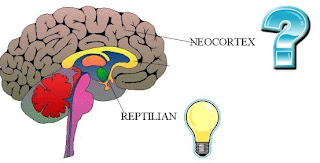What it is the difference between innovation and entrepreneurship?
In a recent
post by my friend Allan Young on "The Startup Myth" he argues that what we need is entrepreneurs not start-ups. To understand the difference he makes the vivid point that entrepreneurs build companies not just try to get money for an idea. The end game is a viable, growing, successful business - the idea is merely a supporting player. This distinction suggests that entrepreneurship and innovation are not the same thing. This post attempts to make that distinction.
First, we need some definitions to work with. From the Web....
- Entrepreneur: "A person who takes the risk of organizing and operating a new business venture."
- Innovation: "The process whereby ideas for new (or improved) products, processes or services are developed and commercialized in the marketplace."

Based on these definitions its easy to see that not all innovations are appropriate for the entrepreneur, e.g. 'new and improved, version 3.0, and next generation.' McDonald's Big Mac was
created to better compete in a local market. Conversely, there are opportunities for the entrepreneur that don't require an innovative idea, e.g. franchises and opening new markets. The Egyptian company building the cell
phone network for North Korea is very entrepreneurial, but not necessarily innovative in the sense that cell phone networks are relatively mature (although I'd guess their way of doing this is different).

The economic model of angel investors or venture capitalists drives them to focus on the intersection because that is where the home runs are. Financially, for every 10 investments made only one will be successful, so EVERY opportunity funded has to have the chance of being the next big thing that covers all the other investments and produces a decent return for the entire portfolio. Since successful entrepreneurs are much scarcer than good ideas, the emphasis is nearly always on the team and not necessarily the idea. As proof, there are people who could get funding without an idea; but no idea will get funded without people.
So if your looking to fund a company what type of innovations should entrepreneurs pursue?
Weaving the ideas of Trout's "
Differentiate or Die", Christensen's "
Innovators Dilemma" and Kim & Mauborgne's "
Blue Ocean Strategy" the best ideas are those that:
- Disrupt the current thinking about how the 'category' is defined in people's mind
- Change the way business is done
- Find net-new money from clients rather than redistributing an existing pot
Hindsight suggests that the successful new companies solve all three requirements simultaneously. They define new categories and hence reap the rewards as it grows as the recognized 'leader' because order of entry is very important. They apply a different business model to the problem at hand - be it distribution model, how and where value is exchanged, mix of product and services, or something nobody else thought of yet so that competitors have to say 'we can't do it that way'. They create a new line-item in people's budget so it isn't so obvious that the money is coming from incumbents who fight to maintain their revenue streams. The definition of competition is the sales guy whose commission check you take.
In summary, violate every possible rule you've been taught and do the impossible:
- Create a need then fill it; people can't tell you what they don't know so don't ask them.
- Do things the industry doesn't do; don't do things they do do.
- Rearrange the rank order of attribute importance; if speed is important sell power consumption.
Talk about risk! If you don't take on all three aspects at the same time any established player can squash you.
- A start up in an existing category will suffer from the classic 'fear, uncertainty, and doubt' sales strategy of the market leader. So, damn them with faint praise as you explain that you do something different.
- A start up that doesn't change the rules of the game, will lose since 'those with money write the rules.' So find that differentiator and make it your sole beachhead.
- A start up that doesn't make people see a problem in a new light will always fail to overcome the inertia to change. So be patient with your audience as they learn to change their way of thinking.
Borrowing some oft-cited examples:
- Southwest Airlines: provided access to second-tier markets; flew point-to-point, not hub-and-spoke; and made affordability the ONLY driver
- Cirque-du-Soleil: circus with a plot line in a strange language; stay-put, integrate music, get rid of animals, stars, and travel; theatrical value vs. individual acts
- Facebook: organize student communities; open the platform to third parties, ignore music; think of it as a cocktail party and not a teenager's bedroom (source)
I spent a good part of the year working and reworking a business plan that focuses on the 'architecture of influence' and social media. In the process I have sat across the table from investors and answered a lot of questions. They want to hear about scale (how will this pay off the others bets we made?), barriers to entry (how will you prevent others from ripping off the idea?), monetization (where is the annuity revenue stream?) and experience (do you have any idea what you're doing?). I probably focused on the innovation side too much, I need to go back to simultaneously addressing all three risks.
In this space "Are you nuts?" is a compliment and means your on the right track.



 The economic model of angel investors or venture capitalists drives them to focus on the intersection because that is where the home runs are. Financially, for every 10 investments made only one will be successful, so EVERY opportunity funded has to have the chance of being the next big thing that covers all the other investments and produces a decent return for the entire portfolio. Since successful entrepreneurs are much scarcer than good ideas, the emphasis is nearly always on the team and not necessarily the idea. As proof, there are people who could get funding without an idea; but no idea will get funded without people.
The economic model of angel investors or venture capitalists drives them to focus on the intersection because that is where the home runs are. Financially, for every 10 investments made only one will be successful, so EVERY opportunity funded has to have the chance of being the next big thing that covers all the other investments and produces a decent return for the entire portfolio. Since successful entrepreneurs are much scarcer than good ideas, the emphasis is nearly always on the team and not necessarily the idea. As proof, there are people who could get funding without an idea; but no idea will get funded without people.














